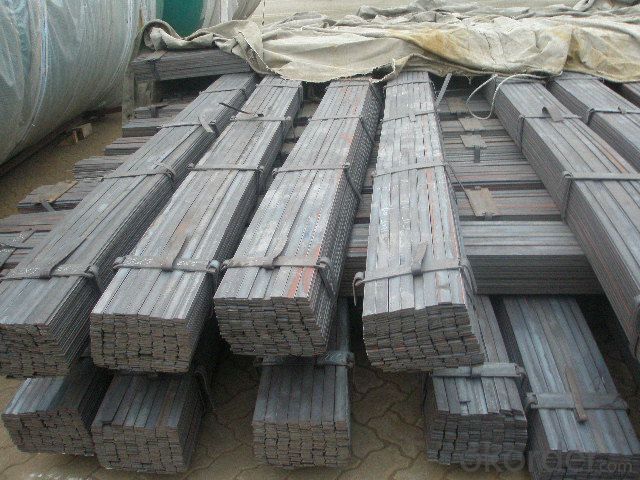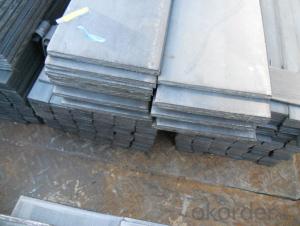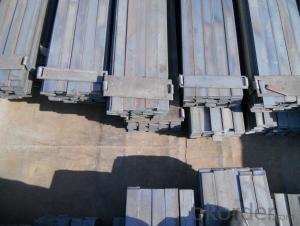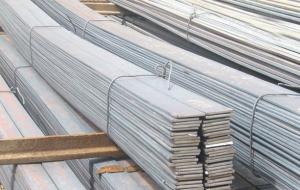Hot Rolled Flat Bars in Grade Q235B with Good price
- Loading Port:
- Tianjin
- Payment Terms:
- TT OR LC
- Min Order Qty:
- 25 m.t.
- Supply Capability:
- 10000 m.t./month
OKorder Service Pledge
OKorder Financial Service
You Might Also Like
Product Description:
OKorder is offering high quality Hot Rolled Steel Flat bars at great prices with worldwide shipping. Our supplier is a world-class manufacturer of steel, with our products utilized the world over. OKorder annually supplies products to European, North American and Asian markets. We provide quotations within 24 hours of receiving an inquiry and guarantee competitive prices.
Product Applications:
Hot Rolled Steel Flat bars are ideal for structural applications and are widely used in the construction of buildings and bridges, and the manufacturing, petrochemical, and transportation industries.
Product Advantages:
OKorder's Steel Flat bars are durable, strong, and resist corrosion.
Main Product Features:
· Premium quality
· Prompt delivery & seaworthy packing (30 days after receiving deposit)
· Corrosion resistance
· Can be recycled and reused
· Mill test certification
· Professional Service
· Competitive pricing
Product Specifications:
Manufacture: Hot rolled
Grade: Q195 – 235
Certificates: ISO, SGS, BV, CIQ
Length: 6m – 12m, as per customer request
Packaging: Export packing, nude packing, bundled
Chemical composition of Q235
Alloy No | Grade | Element(%) | ||||
C | Mn | S | P | Si | ||
Q235 | B | 0.12—0.20 | 0.3—0.7 | ≤0.045 | ≤0.045 | ≤0.3 |
Physical properties of Q235
Alloy No | Grade | Yielding strength point(Mpa) | Tensile strength (Mpa) | Elongation after fracture(%) | ||||||
Thickness (mm) | Thickness (mm) | |||||||||
≤16 | >16--40 | >40--60 | >60--100 | ≤16 | >16--40 | >40--60 | >60--100 | |||
≥ | ≥ | |||||||||
Q235 | B | 235 | 225 | 215 | 205 | 375--500 | 26 | 25 | 24 | 23 |
FAQ:
Q1: Why buy Materials & Equipment from OKorder.com?
A1: All products offered by OKorder.com are carefully selected from China's most reliable manufacturing enterprises. Through its ISO certifications, OKorder.com adheres to the highest standards and a commitment to supply chain safety and customer satisfaction.
Q2: How do we guarantee the quality of our products?
A2: We have established an advanced quality management system which conducts strict quality tests at every step, from raw materials to the final product. At the same time, we provide extensive follow-up service assurances as required.
Q3: How soon can we receive the product after purchase?
A3: Within three days of placing an order, we will begin production. The specific shipping date is dependent upon international and government factors, but is typically 7 to 10 workdays.
Images:


- Q: Can steel flat bars be polished or buffed?
- Indeed, it is possible to polish or buff steel flat bars. Polishing or buffing entails utilizing abrasive materials to eliminate any flaws or marks present on the steel's surface. This technique aids in augmenting the aesthetic appeal of the steel flat bars, bestowing upon them a sleek and glossy appearance. Moreover, polishing or buffing also contributes to enhancing the steel's resistance against corrosion by eradicating any impurities or oxidation on its surface.
- Q: What are the fire-resistance properties of steel flat bars?
- Steel flat bars have excellent fire-resistance properties. Due to their high melting point and low thermal conductivity, they can withstand high temperatures for a prolonged period without losing their structural integrity. Additionally, steel does not contribute to the spread of flames or emit toxic gases when exposed to fire, making it a reliable choice for fire-resistant applications.
- Q: Can steel flat bars be used for support brackets or frames?
- Yes, steel flat bars can be used for support brackets or frames. Steel flat bars are known for their high strength and durability, making them ideal for providing structural support. They can be used to construct brackets or frames in various applications such as building construction, furniture manufacturing, or even in automotive or aerospace industries. Steel flat bars offer excellent load-bearing capacity and resistance to bending, making them reliable and sturdy options for support brackets or frames. Additionally, they are versatile and can be easily welded, drilled, or machined to meet specific design requirements.
- Q: Are steel flat bars available in different surface treatments?
- Yes, steel flat bars are available in different surface treatments.
- Q: What are the different types of surface treatments for steel flat bars?
- Steel flat bars can be treated with various surface treatments, each serving a specific purpose and providing unique benefits. Some commonly used surface treatments for steel flat bars are as follows: 1. Hot-dip galvanizing: Immersing the steel flat bar in molten zinc forms a protective layer on its surface. This treatment offers excellent corrosion resistance and durability, making it ideal for outdoor applications. 2. Powder coating: A dry powder is applied to the surface of the steel flat bar and then cured with heat. This creates a tough and durable finish that is resistant to chipping, scratching, and fading. Powder coating is available in a wide range of colors and enhances the aesthetic appeal of the steel flat bar. 3. Electroplating: A thin layer of metal, such as chrome, nickel, or zinc, is deposited onto the surface of the steel flat bar through an electrochemical reaction. This treatment improves corrosion resistance, enhances appearance, and provides specific functional properties based on the chosen metal. 4. Paint coating: Applying a paint coating to the surface of the steel flat bar offers both protection and aesthetics. Paint coatings can be customized to meet specific requirements and are available in various types such as epoxy, polyurethane, and acrylic. They provide good corrosion resistance and can be reapplied when needed. 5. Anodizing: Although primarily used for aluminum, anodizing can also be applied to steel. This process involves creating an oxide layer on the surface of the steel flat bar through an electrolytic process. Anodizing enhances corrosion resistance and can be combined with coloring techniques to achieve a decorative finish. 6. Phosphating: Phosphating is a chemical treatment that converts the surface of the steel flat bar into a layer of phosphate crystals. This treatment improves corrosion resistance, provides an excellent base for subsequent coatings or paints, and enhances the adhesion of lubricants. 7. Shot blasting: Shot blasting is a mechanical surface treatment that involves propelling abrasive particles onto the surface of the steel flat bar at high speeds. This process removes impurities, rust, scale, and creates a textured finish, thus improving the adhesion of subsequent coatings. Each of these surface treatments offers distinct advantages and should be selected based on the specific requirements of the intended application, desired appearance, and the level of corrosion resistance needed for the steel flat bar.
- Q: What is the cost of steel flat bars?
- The price of steel flat bars may fluctuate due to several factors, including the steel grade, bar size, thickness, and the quantity being acquired. Typically, the cost of steel flat bars ranges between $10 and $50 per bar. Nevertheless, it is crucial to bear in mind that these figures are mere approximations and are subject to substantial variations depending on prevailing market conditions and individual suppliers. To obtain precise pricing information, it is advisable to reach out to local steel suppliers or consult online marketplaces for the latest updates.
- Q: How to use -40*4 galvanized steel bar to do grounding electrode?
- The -40*4 galvanized flat steel is used as the grounding electrode, and the horizontal grounding electrode needs to be welded with the lead wire.
- Q: Lightning protection grounding, what is called three surface welding?
- Lightning protection, grounding, the three sides of the welding:The buried depth of the grounding body shall not be less than 1m at the top, and the steel pipe grounding body shall be vertically configured.The length of the vertical grounding body shall not be less than 2.5m, and the spacing between them shall not be less than 5m.
- Q: Can steel flat bars be used in the manufacturing of agricultural machinery?
- Yes, steel flat bars can be used in the manufacturing of agricultural machinery. Steel flat bars offer high strength and durability, making them suitable for various components and structures in agricultural machinery such as frames, brackets, and supports. They can withstand heavy loads, provide stability, and withstand harsh environmental conditions commonly encountered in agricultural operations. Additionally, steel flat bars can be easily fabricated, welded, and machined to meet specific design requirements, making them a versatile choice for manufacturing agricultural machinery.
- Q: The difference between galvanized round bar and galvanized flat steel
- It has been widely used in the fields of hardware, construction, automobile, shipbuilding, petrochemical, machinery, medicine, food, electricity, energy, space, etc.. The most extensive machining of general machine parts, general rod type steel parts, CD pole, bolt, nut.
Send your message to us
Hot Rolled Flat Bars in Grade Q235B with Good price
- Loading Port:
- Tianjin
- Payment Terms:
- TT OR LC
- Min Order Qty:
- 25 m.t.
- Supply Capability:
- 10000 m.t./month
OKorder Service Pledge
OKorder Financial Service
Similar products
Hot products
Hot Searches
Related keywords


























